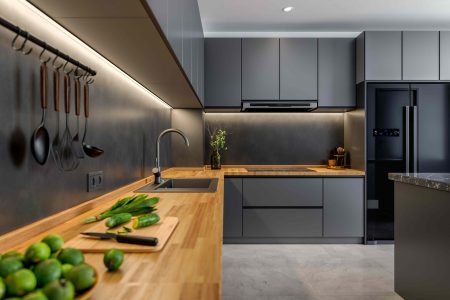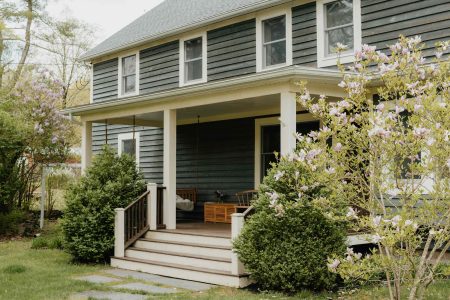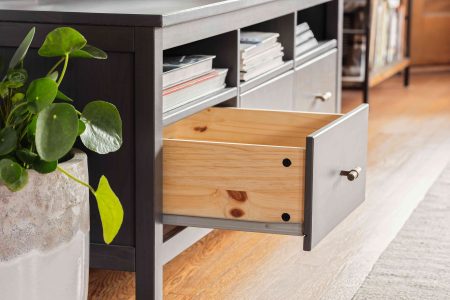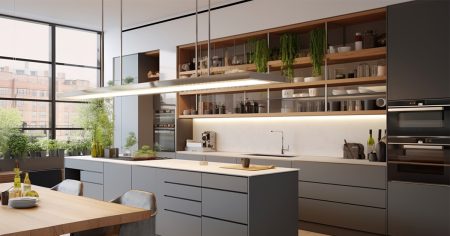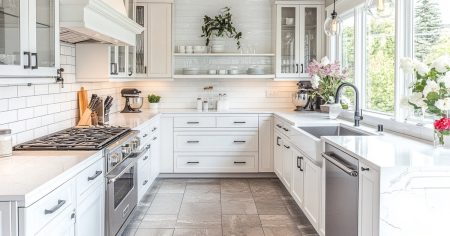If a full kitchen remodel feels daunting and a bit on the expensive side, consider a simple alternative: painting the kitchen. Nothing can match the updated sparkle, ease, and low cost of a kitchen paint job.
While painting bedrooms, hallways, and living rooms means tackling vast amounts of wall space, kitchens tend to have limited paintable areas. Most of a kitchen’s wall space is consumed by base cabinets, wall cabinets, sinks, appliances, and backsplashes. You have far less square footage to deal with. The smaller paintable areas usually will need extensive cleaning and prep work. But tools like TSP cleaner and primer speed up the prep to help you get the walls into shape for painting.
TSP
TSP, or tri-sodium phosphate, is a strong cleansing agent that cuts through grease, grime, soot, and more. It’s an odorless dry powder that must be combined with water to create a solution that can be sponged onto walls, floors, ceilings, furniture, or anywhere else where dirt and grime might accumulate. Some states do not allow the use of TSP; in that case, phosphate-free alternatives are available.
What You’ll Need
Equipment / Tools
- 1 paintbrush, 2 1/2-inch
- 1 roller frame
- 3 roller covers
- 1 paint tray
- 3 paint tray liners
- 2 canvas drop cloths
- 1 dust mask or respirator
- 1 shop vacuum
- 2 tack cloths
- 2 soft, clean cotton rags
Materials
- 2 gallons interior acrylic-latex paint, satin or eggshell
- 1 gallon primer
- 4 packs masking film
- 1 roll painter’s tape
- 1 box TSP (tri-sodium phosphate) or alternative
Instructions
-
Determine the Area to be Painted
Figure out the square footage of your walls so you know how much paint to buy. In a new-construction kitchen, the room will be empty of everything but drywall. Calculate the square footage of each wall by multiplying room height (likely 8 feet) by room length (variable). Add up all walls to get the total. For a precise figure, add up all of the large cutouts such as windows and doors, then subtract them.
-
Choose the Kitchen Paint
The kitchen gets a lot of attention, so choose your kitchen paint colors wisely. The best kitchen colors tend to have a high visual impact and blend well with cabinets and flooring.
Choosing the right type of paint gloss or sheen is more important in the kitchen than in other rooms, except for the bathroom. Gradations of glossiness run from matte (flat, non-shiny) at one end up to high-gloss (so shiny you can almost see your face). Most people do not choose either flat or gloss, opting for the middle ground of eggshell, satin, and semi-gloss paint sheens. as the best paint finish for the kitchen.
-
Clean Most Surfaces to Be Painted
Unless you are dealing with an empty room with fresh drywall, the kitchen walls will need a lot of cleaning. Not every surface needs to be cleaned. If the surface looks and feels clean, it likely can be primed and painted only. If you aren’t sure, err on the side of caution and clean the surface.
Kitchens can build up grease in certain areas, so it’s best to thoroughly clean the walls with a degreaser prior to priming. Assume that areas above and around the stove, oven, and counters need to be cleaned with warm water and TSP (tri-sodium phosphate). Door trim usually can benefit from the TSP cleaning, too. Remove dust and cobwebs from the tops of baseboards and other trim with a vacuum and a damp cloth or tack cloth.
-
Let the Kitchen Dry
Cleaning with TSP adds water to the surfaces, and the water must fully dry before painting. On warm days, open the windows and let the kitchen naturally dry out.
-
Mask and Cover the Kitchen
For the empty room with no finished floor, masking and covering are not needed. Paint drips on the subfloor will be covered by the floor covering. Lay a canvas drop cloth on the floor. Drape large objects such as cabinets, appliances, and tables with plastic sheeting or with masking film. If using a paint sprayer, be sure to drape plastic over doors to adjacent rooms to prevent paint mist from migrating.
-
Apply Painter’s Tape
Apply painter’s tape to the trim and all other areas that will not be painted. Press firmly on the tape with your fingers to prevent bleed-through.
-
Apply Primer
If a surface has already been painted and the paint is in good, clean condition, it will most likely not need priming. Unpainted drywall, bare wood, and painted surfaces in poor condition should be primed. Apply the primer with the roller on large areas and with the brush on areas too small to accommodate the width of the roller.
-
Roll the Large Areas
Determine which areas are large enough to accommodate the roller. Pour a small amount of paint in the tray, soak the roller cover, then thoroughly roll out the excess. Roll the large spaces of the wall in a W-pattern, covering sections of about 4 feet by 4 feet. Bring the roller to about an inch or two of the painter’s tape.
-
Brush the Paint
Let the paint dry for about two hours. Dip the paintbrush in the paint and manually paint the areas that the roller could not reach. Avoid drips by minimally applying the paint and by re-brushing. Areas that were painted more than a few minutes ago will likely already be filming over. So, confine your re-brushing to areas that were only recently painted.
-
Apply Additional Coats
Paint colors deepen and reach their full potential by being applied in two or even three coats. At a minimum, let the paint dry for at least a couple of hours, then re-roll and re-brush the paint one more time.
When to Call a Professional
Painting a kitchen should be within the skill set of most DIYers, especially given the smaller scale when compared to other parts of the home. But you may want to have a paint contractor paint your kitchen if it is large, have a complex layout, or high ceilings. A professional painter can get to the out-of-the-way areas, plus they can address the often unusual geometry found in many kitchen spaces.
Read the full article here




